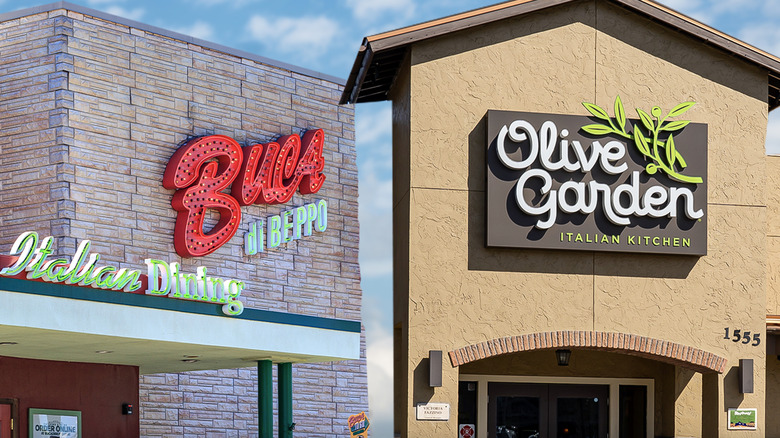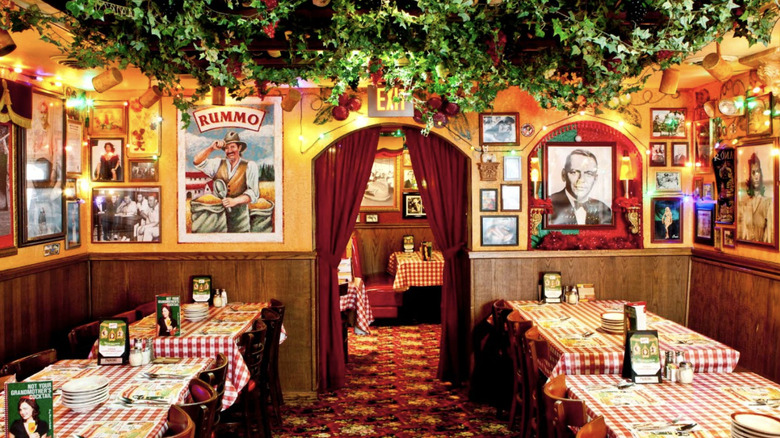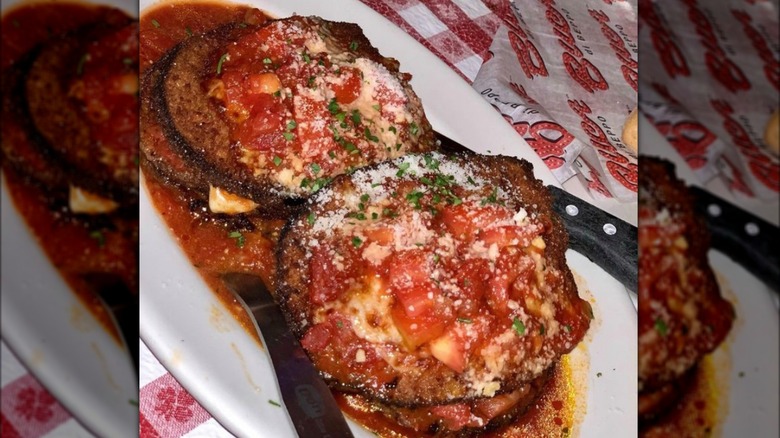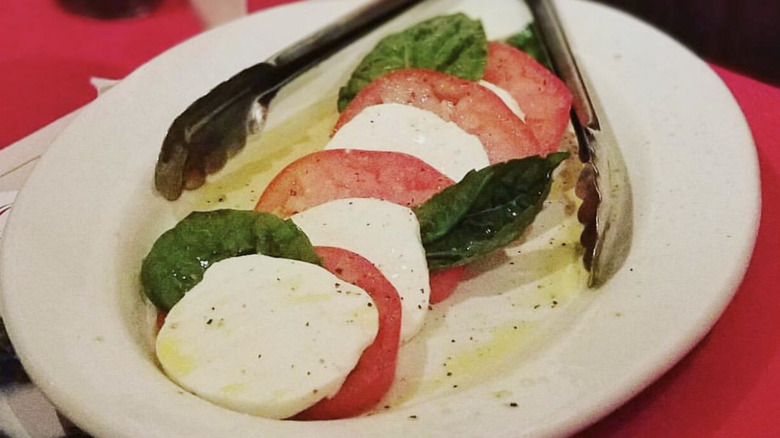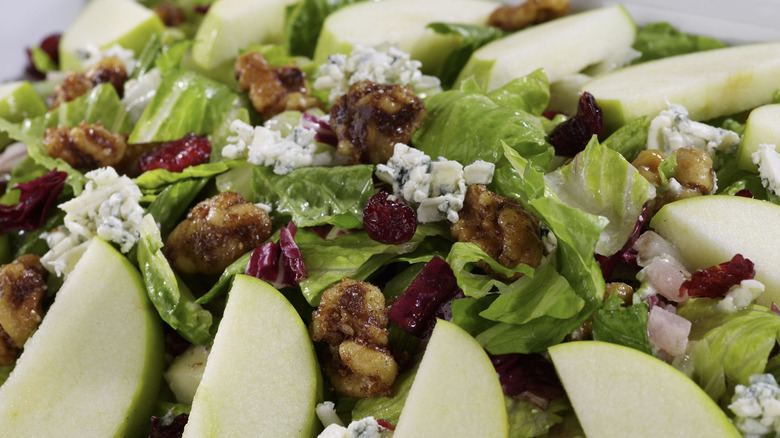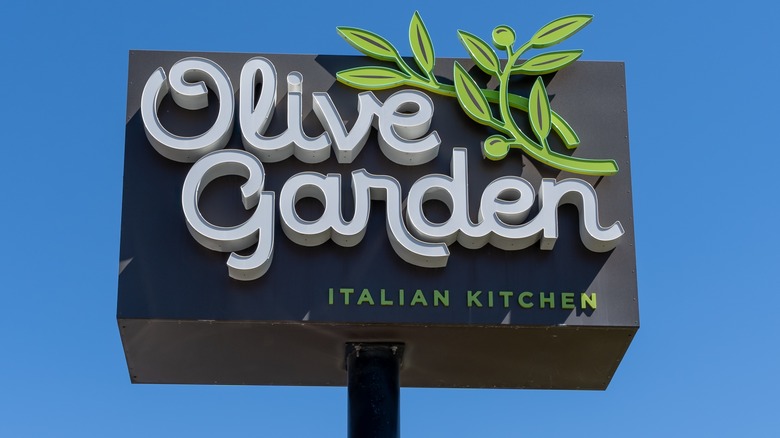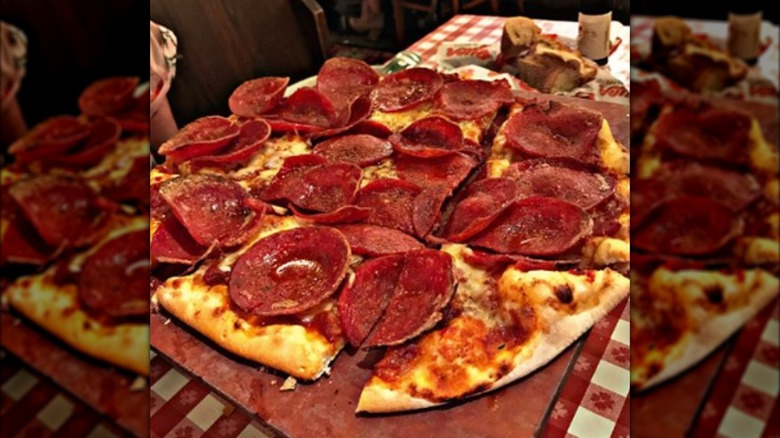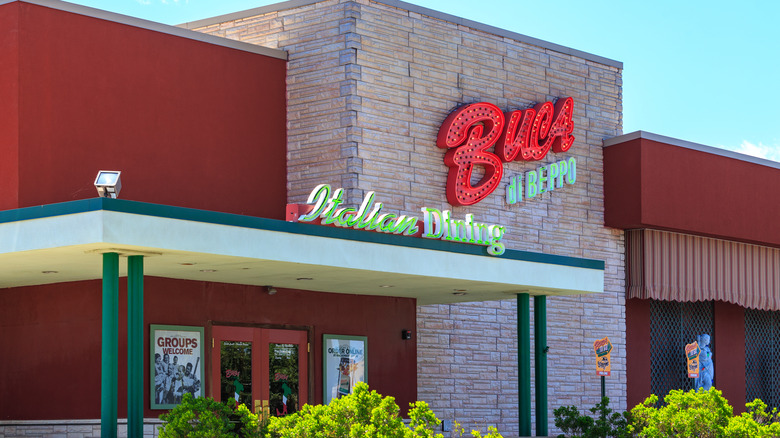Buca Di Beppo Vs Olive Garden: Everything You Need To Know
Buca Di Beppo and Olive Garden are both popular Italian-inspired restaurant chains, each offering a different dining atmosphere and slightly different dish selection. While this may come as a surprise to some, Olive Garden was already in operation around a decade before the first Buca Di Beppo restaurant opened its doors.
Founded by General Mills (another surprise) in 1982, Olive Garden quickly became known for its casual and approachable take on Italian-American cuisine. In contrast, Buca Di Beppo, which opened in 1993, took a different approach, emphasizing large portions and family-style dining. The restaurant also became known for its eclectic decor, typified by Italian-themed photographs and memorabilia, as well as themed dining rooms.
If you're hankering for a little Italian-American fare and can't quite make up your mind whether you should head to Olive Garden or Buca Di Beppo, we are here to help. We have spent hours comparing both chains, so you can choose the restaurant that best suits your mood and culinary cravings. For more information about our research process, take a look at the methodology slide at the end of this article.
Buca Di Beppo is known for its quirky decor
Buca Di Beppo is all about family-style dining in an unpretentious and downright boisterous atmosphere. The restaurant's decor reflects this vibe. Tacky and unapologetic, Buca Di Beppo was once described by its founder as "intentionally in bad taste, but good-natured bad taste" (via Bon Appétit). Through thick and thin, the restaurant has stuck to its kitschy aesthetics.
The first thing that strikes most guests when they enter Buca Di Beppo are the countless vintage photographs that line the restaurant's walls. From Italian-American family photos to images of iconic Italian personalities such as Sophia Loren, the restaurant pays homage to the rich heritage of Italian culture in America. Many Buca restaurants also feature a "Chef's Table" where guests can sample the chain's dishes and chat with the people who prepared them.
One of the restaurant's highlights are its themed rooms, including the "Poster Room" adorned with countless vintage Italian posters. In the "Wine Room," diners will find themselves in an over-the-top world of vines, wine bottles, and twinkle lights. However, perhaps the most unusual of Buca's dining areas is the "Pope Room" where guests can dine amid memorabilia dedicated to past pontiffs. Each "Pope Room" also features a lazy Susan-style "Pope Table" set up with the bust of the pope in the center.
Olive Garden features a contemporary design
Olive Garden's aesthetic has evolved throughout the years. Initially inspired by the welcoming warmth of a Tuscan farmhouse, the chain's original design featured plenty of wooden elements, stonework, columns, and brick arches. Meanwhile, the restaurant's walls were adorned with murals of cypress trees and pottery, mimicking the charm of Italian landscapes.
The chain started shedding its Tuscan-inspired look in favor of a more modern aesthetic in 2014. More specifically, the restaurant transitioned from a rustic, rural decor to a more contemporary design with the goal of appealing to a broader customer base. Walls and columns were removed to create a more open and spacious design, and more colors and textures were introduced to give the interiors a fresh feel.
One of the biggest parts to Olive Garden's rebranding effort included the introduction of a new logo. The restaurant's old logo featured cursive font and a vine of purple grapes on a papier-mâché stucco background — all elements that emphasized its rustic, Tuscan-inspired aesthetic. Marking a departure from the chain's previous look, the new logo is more muted, featuring a clear and simpler font and a stylized olive branch.
Buca Di Beppo's Italian dishes are a little more traditional
While this may come as a surprise to some, Buca Di Beppo wasn't founded by an Italian or an American-Italian, for that matter. Instead, the restaurant was first opened by a Lutheran from Illinois who knew very little about authentic Italian fare. While this may explain Buca's religious paraphernalia, it does little to show how its menu became so — well — classically Italian. Some of the chain's signature dishes include eggplant parmigiana, chicken Marsala, meatballs, and a range of pizzas. Many of the dishes are large enough for sharing to encourage communal, Italian-style dining.
Unlike Buca Di Beppo's more traditional approach, Olive Garden's definition of American-Italian cuisine is a bit more flexible. Olive Garden's menu features a wide range of dishes, many of which have been adapted to suit the tastes of its American patrons. Some of these include creations such as spinach and artichoke dip, Parmesan-breaded lasagna fritta, and toasted ravioli, as well as a range of Americanized fettuccine Alfredo recipes with ingredients such as chicken tortelloni, shrimp, and seafood. While many of Olive Garden's dishes are served in individual portions, the restaurant also offers family-sized pans for sharing.
Both restaurants offer a wide range of appetizers
Depending on your dining style, appetizers can play a crucial role in the overall experience. These small dishes not only whet the appetite before the main meal, but also give diners a chance to sample a range of flavors and textures, particularly if they're ordered for sharing. This is why if you're ordering starters for the table, it's nice to have a diverse range of choices to ensure that everybody can enjoy something that suits their taste preferences.
Buca Di Beppo and Olive Garden offer a selection of around 10 different appetizers, with both chains serving fried mozzarella, meatballs, and fried calamari. Aside from these crispy delights, Buca also offers standard garlic bread and Mozzarella Garlic Bread, as well as classic bruschetta with Roma tomatoes, fresh mozzarella, and red onion. The chain's other appetizers include Prosciutto Stuffed Mushrooms, Spicy Shrimp, and Mozzarella Caprese with vine-ripened tomatoes, fresh mozzarella, and fresh basil.
Olive Garden's appetizer menu is pretty heavy on deep fried options — the exceptions being the Spinach-Artichoke Dip and Meatballs Parmigiana. The chain's golden-browned apps include Stuffed Ziti Fritta, Lasagna Fritta, Shrimp Fritto Misto, and Toasted Beef Ravioli that's actually lightly fried.
Olive Garden offers more entrées than Buca Di Beppo
Olive Garden has more than three times the number of entrées offered at Buca Di Beppo, giving diners a wide variety of options. These include beloved Italian dishes and more modern takes on Mediterranean recipes. Some of the restaurant's more traditional offerings include Eggplant Parmigiana with hand-breaded eggplant, marinara sauce, and mozzarella and Lasagna Classico with Parmesan, mozzarella, pecorino Romano. The chain also serves more Americanized versions of Italian plates like Chicken Tortellini Alfredo, Shrimp Scampi with angel hair pasta, and Grilled Chicken Margherita served with tomatoes, basil pesto, mozzarella, and lemon and garlic sauce.
While the entrée selection at Buca Di Beppo is more limited, most of the chain's main dishes are steeped in Italian culinary tradition. The Chicken Saltimbocca, for instance, is a classic Roman dish that translates to "jump in your mouth" in Italian. Made with poultry, the plate features prosciutto, artichokes, sage, capers, and lemon butter sauce. Buca's other Italian-inspired creations include Chicken Marsala, made with traditional Marsala wine, Salmon Sorrento, and Chicken Parmigiana.
Buca Di Beppo serves more salads and Olive Garden offers more soups
To balance its other, heavier dishes, Buca Di Beppo serves four family-portioned salads. At the simpler end of the scale, the restaurant's mixed greens consist of Roma tomatoes, red onions, pepperoncini, olives, and Italian vinaigrette. For diners looking for something heartier, the chopped antipasti salad comes with Roma tomatoes, lettuce, pepperoncini, pepperoni, salami, red onions, olives, provolone, gorgonzola, and feta. There are also the options of a Caesar salad with Romaine lettuce and an apple gorgonzola salad with spiced walnuts and cranberries.
While Olive Garden doesn't excel in the salad department, offering only one basic salad option, it makes up for this by serving a range of soups. The chain's homemade offerings include a vegan-friendly minestrone soup with veggies, beans, and pasta. For patrons seeking something gluten-free, the Zuppa Toscana features spicy Italian sausage, russet potatoes, and kale in a creamy broth. On the more filling front, Olive Garden's Chicken & Gnocchi soup is made with Italian dumplings, roasted chicken, and spinach. Meanwhile, the restaurant's Pasta e Fagioli comes with ground beef, beans, tomatoes, and tubetti pasta.
Both Olive Garden Buca Di Beppo offer gluten-free options
Those with gluten sensitivity or celiac disease can find dining out at restaurants somewhat challenging. Despite the growing awareness of gluten-related issues, not all restaurants cater to people with these special dietary requirements. Luckily, both Olive Garden and Buca Di Beppo offer a range of gluten-free menu options.
Olive Garden serves several gluten-free dishes for both adults and children, including rotini pasta with either marinara or meat sauce. The chain's other dishes made with gluten-free ingredients include Zuppa Toscana with spicy Italian sausage, Grilled Chicken Parmigiana, Herb-Grilled Salmon with garlic herb butter, and a 6-ounce sirloin steak served with Parmesan garlic broccoli.
While Buca Di Beppo doesn't offer gluten-free entrées, it does have some options for diners allergic to gluten. One of these is the Mozzarella Caprese with vine-ripened tomatoes, fresh mozzarella, and basil and the Chopped Antipasti salad with lettuce, Roma tomatoes, salami, pepperoni, olives, feta, and gorgonzola. The chain also offers numerous gluten-free side dishes, such as broccoli with garlic, sausage links, and green beans.
Olive Garden has more locations than Buca Di Beppo
Olive Garden has grown by leaps and bounds since the restaurant opened its doors in 1982. Within the first seven years, the chain already had 145 locations, positioning it as the fastest expanding chain at the time. Today, Olive Garden has over 900 restaurants across the U.S., with the largest footprint in Texas with 111 locations, California with 79 locations, and Florida with 77 restaurants. The cities with the greatest number of Olive Garden restaurants are Houston and San Antonio in Texas and Orlando in Florida. The chain also has close to 50 international outlets in countries including Mexico, Canada, Brazil, and Saudi Arabia.
Buca Di Beppo is a much smaller chain than Olive Garden, with the number of its locations currently shrinking rather than expanding. The first Buca Di Beppo opened as "Buca Little Italy" in the basement of an apartment building in Minneapolis, Minnesota in 1993. The chain gradually grew to over 95 locations. Unfortunately, this growth hasn't been sustained. Today, Buca Di Beppo has just 46 restaurants in the U.S. and one in Manila in the Philippines. In fact, in August 2024, Buca Di Beppo filed for bankruptcy, citing an inability to recover from the sharp decline in customer numbers during the pandemic.
Olive Garden has a wider kid's menu
While both Olive Garden and Buca Di Beppo are family-friendly, the former restaurant offers more options for young diners. Available for children under 12, the mini dishes are all priced at $7.99, with the exception of the Kids Grilled Chicken with Rotini Pasta and Marinara, which costs $10.98. The other child-sized pasta dishes on offer at the restaurant include Kids Rotini with Marinara, Kids Rotini with Meat Sauce, Kids Alfredo Sauce with Choice of Pasta, Kids Macaroni & Cheese, and Kids Five Cheese Marinara with Choice of Pasta. Alternatively, little steps can opt for a mini pizza, chicken fingers, or cheese ravioli.
Buca Di Beppo's menu features only three items for kids under the age of 10. The three dishes are all priced at $10.99 and include one drink. Just like Olive Garden, Buca Di Beppo offers a mini-sized macaroni and cheese and fettuccine Alfredo. The restaurant's only dish that differs from Olive Garden's menu selection for kids is spaghetti with red sauce and an oversized meatball.
Buca Di Beppo serves pizza
Pizza was first mentioned by name in a Southern Italian text over a thousand years ago, where the son of a feudal lord made a promise to deliver 12 pizzas a year to the local bishop. However, at that time, the pizza was probably more akin to a flatbread than the dish we know and love today. Modern-day pizza originated in Naples in the 18th century, where it was used as a cheap food source by peasants who arrived in the city from the countryside.
Being a slightly more traditional Italian restaurant than Olive Garden, Buca Di Beppo serves pizza. Diners can choose from four options. On the more minimalist side, the chain offers Margarita with mozzarella and fresh basil and Pizza con Formaggio with mozzarella and garlic-infused olive oil. Carnivores can opt for the restaurant's pepperoni option with mozzarella and provolone cheeses. Alternatively, the Spicy Arrabbiata offers a kick with zesty Italian sausage, pepperoni, caramelized onion, as well as gorgonzola, mozzarella, and provolone cheeses.
Methodology
Buca Di Beppo and Olive Garden are very similar in some respects and different in others. Both chain restaurants serve Italian-inspired staples such as pasta, lasagna, and eggplant parmigiana. Additionally, both restaurants are known for their generous portions and family-style dining. However, despite their commonalities, the two chains are also very different, offering very distinct dining environments and unique approaches to Italian-inspired dining.
To compare Buca Di Beppo and Olive Garden, we have taken into account a number of factors. Firstly, we considered each restaurant's decor and atmosphere. Next, we evaluated each chain's menu items, focusing on the variety of the dishes on offer. Finally, we took into account how accessible the restaurants are based on the number of their locations.
